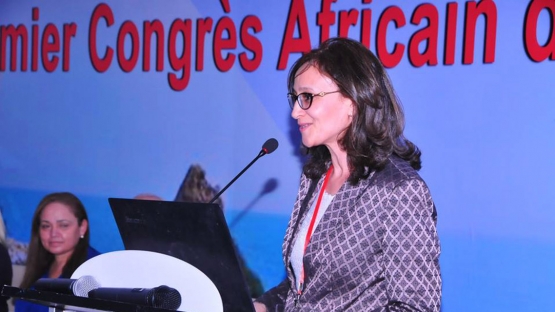The First African Congress on Nutrition ‘Premier Congrès Africain de Nutrition’, focusing on childhood obesity in Africa, has taken place from 6-8 October 2017 in Hammamet, Tunisia. The congress brought together 176 participants from Algeria, Morocco, France, Tunisia, Senegal and Burkina Faso. The IAEA supported several Congress sessions, including one dedicated to a regional IAEA technical cooperation (TC) project on designing and evaluating interventions to reduce obesity and related health risks[1]. Support for the event was also provided through a national TC project[2].
Africa is currently undergoing nutritional and social transitions, which have triggered a growing problem of obesity and related non-communicable diseases in the region. Through its TC programme, the IAEA is helping Member States to address important development challenges such as childhood obesity and other forms of malnutrition, by building capacities in the peaceful applications of nuclear science and technology.
The IAEA supports its Member States in using nuclear and isotopic techniques to improve nutrition throughout a person’s life course, from measuring exclusive breastfeeding in infants to nutrient uptake and body composition in different age groups to bone density, muscle mass and physical activity in the elderly.
To read more on how these techniques are used, please see our page on childhood obesity.
The regional TC project featured at the First African Congress targeted childhood obesity among primary school children aged 8-11 in eleven countries: Benin, Ghana, Kenya, Mali, Mauritius, Morocco, Namibia, Senegal, Uganda, the United Republic of Tanzania and Tunisia. Seven presenters shared preliminary results on work related to the project with the Congress participants. Presentations included: Determination of Body Composition by the Stable Isotope Dilution Technique; Validation of Bioelectrical Impedance Measurement versus Isotopic Deuterium Dilution for the Measurement of Adiposity in School-age Children in Senegal; Obesity in Children and Lactating Women in Morocco: Objective View; Determination of the Level of Physical Activity by Accelerometry in Children in Tunisia; Levels of Physical Activity and Obesity among Moroccan School-aged Children; Effet d'un exercice aigu sur le sommeil et la prise alimentaire du lendemain chez l'adolescente obèse; and Alimentation de jeunes adolescents de milieu aisé.






